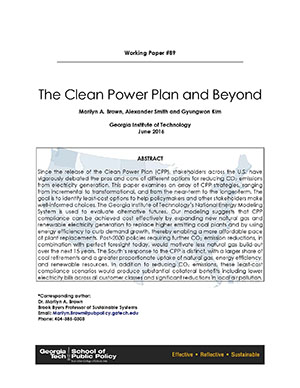(Download the full report and technical appendices)
 Since the release of the Clean Power Plan (CPP), stakeholders across the U.S. have vigorously debated the pros and cons of different options for reducing CO2 emissions from electricity generation. This paper examines an array of CPP strategies, ranging from incremental to transformational, and from the near-term to the longer-term. The goal is to identify least-cost options to help policymakers and other stakeholders make well-informed choices. The Georgia Institute of Technology’s National Energy Modeling System is used to evaluate alternative futures. Our modeling suggests that CPP compliance can be achieved cost effectively by expanding new natural gas and renewable electricity generation to replace higher emitting coal generation and by using energy efficiency to curb demand growth, thereby enabling a more affordable pace of plant replacements. Post-2030 policies requiring further CO2 emission reductions, in combination with perfect foresight today, would motivate less natural gas build-out over the next 15 years. The South’s response to the CPP is distinct, with a larger share of coal retirements and a greater proportionate uptake of natural gas, energy efficiency, and renewable resources. In addition to reducing CO2 emissions, these least-cost compliance scenarios would produce substantial collateral benefits including lower electricity bills across all customer classes and significant reductions in local air pollution.
Since the release of the Clean Power Plan (CPP), stakeholders across the U.S. have vigorously debated the pros and cons of different options for reducing CO2 emissions from electricity generation. This paper examines an array of CPP strategies, ranging from incremental to transformational, and from the near-term to the longer-term. The goal is to identify least-cost options to help policymakers and other stakeholders make well-informed choices. The Georgia Institute of Technology’s National Energy Modeling System is used to evaluate alternative futures. Our modeling suggests that CPP compliance can be achieved cost effectively by expanding new natural gas and renewable electricity generation to replace higher emitting coal generation and by using energy efficiency to curb demand growth, thereby enabling a more affordable pace of plant replacements. Post-2030 policies requiring further CO2 emission reductions, in combination with perfect foresight today, would motivate less natural gas build-out over the next 15 years. The South’s response to the CPP is distinct, with a larger share of coal retirements and a greater proportionate uptake of natural gas, energy efficiency, and renewable resources. In addition to reducing CO2 emissions, these least-cost compliance scenarios would produce substantial collateral benefits including lower electricity bills across all customer classes and significant reductions in local air pollution.
Presentation and Video:
- PowerPoint for the U.S. Department of Energy: June 22, 2016: The Clean Power Plan and Beyond: Key Roles for Energy Efficiency
- PowerPoint for Stanford University: June 1, 2016: The Clean Power Plan and Beyond
- Video of May 3, 2016 Webinar
Impacts onHousehold Energy Bills:
single-family homes, apartments, and mobile homes |
Impacts onCommercial Energy Bills:
|
Impacts onIndustrial Energy Bills:
|
|---|---|---|
- Methodology for estimating the potential for household energy bill savings, by state.
- Methodology for estimating the potential for energy bill savings in commercial buildings, by state.
- Methodology for estimating the potential for energy bill savings in industry, by state.


 office buildings, schools, and others
office buildings, schools, and others  aluminum and steel, pulp and paper, and others
aluminum and steel, pulp and paper, and others